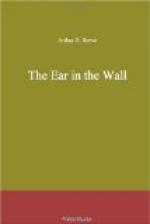“In ordinary typewriting,” replied Craig, “each letter occupies an imaginary square, ten to the inch horizontally and six to the inch vertically. Typewriting letters are in line both ways. This ruled glass plate is an alinement test plate for detecting defects in alinement. I have also here another glass plate in which the lines diverge each at a very slightly different angle—a typewriting protractor for measuring the slant of divergence of various letters that have become twisted, so to speak.
“When it is in perfect alinement the letter occupies the middle of each square and when out of alinement it may be in any of the four corners, or either side of the middle position or at the top or bottom above or below the middle. That, you see, makes nine positions in all—or eight possible divergences from normal in this particular alone.”
Clare had been using the protractor herself, quickly familiarizing herself with it.
“Another possible divergence,” went on Kennedy, “is the perpendicular position of the letter in relation to the line. That is of great value in individualizing a machine. It is very seldom that machines, even when they are new, are perfect in this particular. It does not seem much until you magnify it. Then anyone can see it, and it is a characteristic that is fixed, continuous, and not much changed by variations in speed or methods of writing.
“Here’s another thing. Typewriter faces are not flat like printing type, but are concaved to conform to the curve of the printing surface of the roller. When they are properly adjusted all portions should print uniformly. But when they are slightly out of position in any direction the two curved surfaces of type and roller are not exactly parallel and therefore don’t come together with uniform pressure. The result is a difference in intensity in different parts of the impression.”
It was fascinating to see Craig at work over such minute points which we had never suspected in so common a thing as ordinary typewriting.
“Then you can identify these letters positively?” asked Clare.
“Positively,” answered Craig. “If two machines of the same make were perfect to begin with and in perfect condition—which is never found to be the case when they are critically examined—the work from one would be theoretically indistinguishable from that of another until actual use had affected them differently. The work of any number of machines begins inevitably to diverge as soon as they are used. Since there are thousands of possible particulars in which differences may develop, it very soon becomes possible to identify positively the work of a particular typewriting machine.”
“How about the operator?” I asked curiously.




